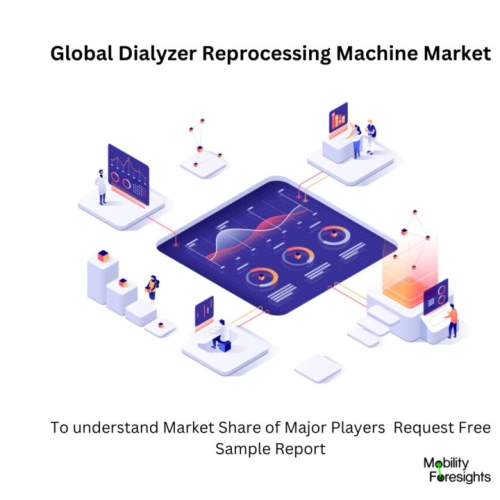
- Get in Touch with Us

Last Updated: Apr 25, 2025 | Study Period: 2024-2030
Dialyzers undergo reprocessing in addition to reuse. Cleaning, testing, filling the dialyzer, checking, labelling, storing, and rinsing the dialyzer are all steps in the reprocessing process before it is utilized for the subsequent treatment. Bleach, hydrogen peroxide, and peracetic acid are a few of the chemical cleaning agents used during dialyzer reprocessing.
Formaldehyde and peracetic acid are two frequently employed chemical sterilants and disinfectants. A technique that uses hot citric acid instead of chemical germicides has been used on occasion.

The Global Dialyzer Reprocessing Machine market accounted for $XX Billion in 2023 and is anticipated to reach $XX Billion by 2030, registering a CAGR of XX% from 2024 to 2030.
Hospitals utilise dialysis machines for reprocessing. For people with diabetes, these devices are used. The heat treatment process renders the reprocessed dialyzers suitable for use in a conventional kidney dialysis procedure.
Dialyzers that have been through a second processing stage are not shared across patients. Patients with CKD or ESRD most frequently receive dialysis as a kind of treatment.
Consequently, it is anticipated that during the projected period, the increased prevalence of these conditions will fuel growth in the worldwide dialyzer reprocessing machine market.
Another aspect that is anticipated to fuel expansion in the market for dialyzer reprocessing machines globally is the rising popularity of home dialysis. Using portable dialysis equipment, home dialysis is a form of renal replacement therapy (RRT) that is carried out at home.
The benefits of this therapy approach include better patient results, more flexible scheduling, and reduced expenses.All of these elements contribute to market expansion.
The market for dialyzer reprocessing equipment will, however, be constrained by high installation costs and new dialyzer systems' higher cost when compared to previously used models.
On the number of people using dialysis, the COVID-19 pandemic had a major detrimental effect. Patients on dialysis had a higher risk of contracting SARS-CoV-2 and dying from it, and many have also received care that was either delayed or was of insufficient quality, which has caused them psychological suffering.
| Sl no | Topic |
| 1 | Market Segmentation |
| 2 | Scope of the report |
| 3 | Abbreviations |
| 4 | Research Methodology |
| 5 | Executive Summary |
| 6 | Introduction |
| 7 | Insights from Industry stakeholders |
| 8 | Cost breakdown of Product by sub-components and average profit margin |
| 9 | Disruptive innovation in the Industry |
| 10 | Technology trends in the Industry |
| 11 | Consumer trends in the industry |
| 12 | Recent Production Milestones |
| 13 | Component Manufacturing in US, EU and China |
| 14 | COVID-19 impact on overall market |
| 15 | COVID-19 impact on Production of components |
| 16 | COVID-19 impact on Point of sale |
| 17 | Market Segmentation, Dynamics and Forecast by Geography, 2024-2030 |
| 18 | Market Segmentation, Dynamics and Forecast by Product Type, 2024-2030 |
| 19 | Market Segmentation, Dynamics and Forecast by Application, 2024-2030 |
| 20 | Market Segmentation, Dynamics and Forecast by End use, 2024-2030 |
| 21 | Product installation rate by OEM, 2023 |
| 22 | Incline/Decline in Average B-2-B selling price in past 5 years |
| 23 | Competition from substitute products |
| 24 | Gross margin and average profitability of suppliers |
| 25 | New product development in past 12 months |
| 26 | M&A in past 12 months |
| 27 | Growth strategy of leading players |
| 28 | Market share of vendors, 2023 |
| 29 | Company Profiles |
| 30 | Unmet needs and opportunity for new suppliers |
| 31 | Conclusion |
| 32 | Appendix |